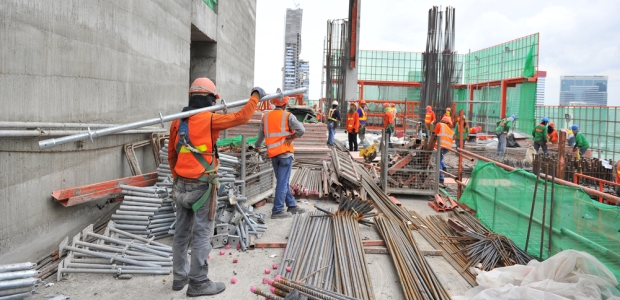
Training By the Book
Reading through the training requirements in OSHA’s construction standards highlights their common elements.
- By Jerry Laws
- Jan 01, 2016
Falls are the leading cause of death on the job for U.S. construction workers, OSHA reminds us—there were 337 fatal falls in this sector alone in 2014, according to preliminary BLS data—so it makes sense that the OSHA construction standards1 dealing with work on scaffolds, fall protection, ladders, and steel erection specify the kind of training workers should receive before undertaking those tasks. And the standards' training elements are consistent.
Preliminary results from the Bureau of Labor Statistics' Census of Fatal Occupational Injuries showed construction deaths rose by 6 percent, to 874, in 2014 from the previous year.
29 CFR 1926.454, Scaffolds
Training requirements:
1926.454(a)—The employer shall have each employee who performs work while on a scaffold trained by a person qualified in the subject matter to recognize the hazards associated with the type of scaffold being used and to understand the procedures to control or minimize those hazards. The training shall include these areas, as applicable:
1926.454(a)(1)—The nature of any electrical hazards, fall hazards and falling object hazards in the work area
1926.454(a)(2)—The correct procedures for dealing with electrical hazards and for erecting, maintaining, and disassembling the fall protection systems and falling object protection systems being used
1926.454(a)(3)—The proper use of the scaffold, and the proper handling of materials on the scaffold
1926.454(a)(4)—The maximum intended load and the load-carrying capacities of the scaffolds used.
In 1926.454(b), employers are directed to have each employee involved in erecting, disassembling, moving, operating, repairing, maintaining, or inspecting a scaffold be trained by a competent person to recognize any hazard associated with the work in question. The training shall include the nature of scaffold hazards; correct procedures for erecting, disassembling, moving, operating, repairing, inspecting, and maintaining the type of scaffold in question; and design criteria, maximum intended load-carrying capacity, and intended use of the scaffold.
When the employer has reason to believe an employee lacks the skill or understanding needed for safe work involving the erection, use, or dismantling of scaffolds (1926.454(b)), the employer shall retrain the employee. And retraining is required when changes at the work site present a hazard on which an employee has not been previously trained; changes in the types of scaffolds, fall protection, falling object protection, or other equipment present a hazard on which an employee has not been previously trained; or inadequacies in an affected employee’s work involving scaffolds indicate the employee has not retained the necessary proficiency.
29 CFR 1926.503, Fall Protection
Training requirements:
1926.503(a)(1)—The employer shall provide a training program for each employee who might be exposed to fall hazards, with the program enabling each employee to recognize the hazards of falling and training each one in the procedures to be followed to minimize these hazards.
1926.503(a)(2)—The employer shall ensure each employee has been trained, as necessary, by a competent person qualified in the following areas:
- The nature of fall hazards in the work area
- The correct procedures for erecting, maintaining, disassembling, and inspecting the fall protection systems to be used
- Use and operation of guardrail systems, personal fall arrest systems, safety net systems, warning line systems, safety monitoring systems, controlled access zones, and other protection to be used
- The role of each employee in the safety monitoring system when this system is used
- Limitations on the use of mechanical equipment during the performance of roofing work on low-sloped roofs
- Correct procedures for handling and storage of equipment and materials and the erection of overhead protection
- The role of employees in fall protection plans.
Employers are required by 1926.503(b)(1) to verify compliance by preparing and also maintaining a written certification record that contains the name or other identity of the employee trained, the date(s) of the training, and the signature of the person who conducted the training or the signature of the employer.
When the employer has reason to believe an employee who has already been trained does not have the required understanding and skill, that employee must be retrained. Retraining is required when changes in the workplace render previous training obsolete, changes in the types of fall protection systems or equipment to be used make prior training obsolete, or inadequacies in an affected employee's knowledge or use of fall protection systems or equipment indicate he hasn't retained the requisite understanding or skill.
29 CFR 1926.761, Steel Erection
Training requirements:
This section says this training shall be provided by a qualified person, and the employer "shall train each employee exposed to a fall hazard in accordance with the requirements of this section. The employer shall institute a training program and ensure employee participation in the program."
Section 1926.761(c) says employers must provide special training to employees engaged in a multiple lift rigging procedure and in controlled decking zone procedures.
29 CFR 1926.1060, Stairways and Ladders
Training requirements:
1926.1060(a)
The employer shall provide a training program for each employee using ladders and stairways, as necessary. The program shall enable each employee to recognize hazards related to ladders and stairways, and shall train each employee in the procedures to be followed to minimize these hazards.
1926.1060(a)(1)
The employer shall ensure that each employee has been trained by a competent person in the following areas, as applicable:
- The nature of fall hazards in the work area
- The correct procedures for erecting, maintaining, and disassembling the fall protection systems to be used
- The proper construction, use, placement, and care in handling of all stairways and ladders
- Maximum intended load-carrying capacities of ladders
And retraining shall be provided for each employee as necessary so that the employee maintains the understanding and knowledge acquired through compliance with this section.
Reference
1. https://www.osha.gov/pls/oshaweb/owastand.display_standard_group?p_toc_level=1&p_part_number=1926
This article originally appeared in the January 2016 issue of Occupational Health & Safety.